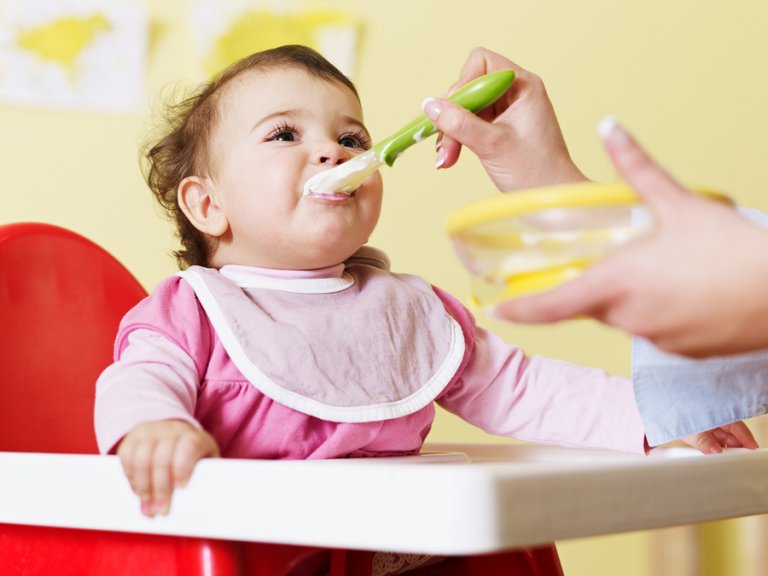7 Vegetable Purees for Babies

You can start to provide your children with vegetable purees after they reach the age of 6 months. These purees are the perfect way to provide little ones with a balanced diet.
Milk, whether maternal or artificial, can only cover all of a baby’s nutritional needs until the age of 6 months. After that, you can think about slightly diversifying his diet and introduce new foods. Vegetable purees can be one of the first dishes to introduce to your baby as he enters this new phase.
Purees are certainly a great way to introduce vegetables into your child’s diet. We’ll provide you with some simple recipes in this article. Keep in mind that you can adapt these recipes according to your child’s tastes and age.
7 vegetable purees for babies
Here are seven excellent and practical recipes for vegetable purees:
Mashed green beans
Ingredients
- 200 grams of fresh mashed green beans.
- Water or milk for babies.
- Olive oil.
Preparation
- First, wash and cut the green beans into very small pieces.
- Steam them for 10 to 15 minutes.
- Chill the beans under a stream of cold water to preserve their color.
- To finish, drain and mix the beans with a few drops of olive oil and milk for babies until you achieve a smooth puree consistency.
Spinach puree
Ingredients
- 150 grams of spinach leaves.
- Water.
- Olive oil.
Preparation
- Wash the spinach leaves well and put them in a pot with boiling water to cook for 5 minutes.
- To finish, steam and mix the product with a little water.

Carrot and zucchini puree
Ingredients
- 2 small carrots.
- 3 zucchinis.
- 2 spoons of cheese.
- 1 basil leaf.
- Olive oil.
Preparation
- Wash and peel the vegetables.
- Cut into small cubes and steam-cook the vegetables for 20 minutes.
- To finish, mix all the ingredients until the product reaches a thick, lump-free consistency.
Carrot and potato puree with Roquefort cheese
Ingredients
- 1 potato.
- 2 small carrots.
- 10 centiliters of milk for babies.
- 1 piece of Roquefort cheese (25 to 30 grams).
Preparation
- Wash, peel and cut the vegetables into small pieces.
- Next, put the potato and carrots in a pan with water and cook for 15 to 20 minutes.
- Heat up the milk in a separate pan and add the sliced Roquefort cheese into the pan until the cheese melts.
- Lastly, mix all the ingredients together until the product reaches a homogeneous texture.
“Vegetable purees are a great way to incorporate vegetables in their diet.”
Pumpkin puree
Ingredients
- 1 piece of pumpkin.
- 1 piece of cheese.
- Water.
- Olive oil.
Preparation
- Peel the pumpkin, remove seeds and filaments.
- Cut the pumpkin into little pieces.
- Cook the pumpkin pieces for 15 minutes.
- Finally, mash the pumpkin pieces when they’re cooked. Then add the cheese, a few drops of olive oil and a little bit of water.
Asparagus puree
Ingredients
- 5 green asparagus.
- 1 potato.
- 1 teaspoon of thick cream.
Preparation
- First, peel the asparagus and wash it with water, then cut them into small pieces.
- Wash and peel the potato, then chop it into small cubes.
- Steam the asparagus and potato for 10 to 15 minutes.
- Check to see when ready with the tip of a knife. The asparagus and potatoes should be tender.
- Mix well until the product reaches the desired texture. Asparagus is very fibrous, so it’s best to pass the puree through a sieve to eliminate threads.
- Finally, add a spoonful of cream.
Potato and artichoke puree
Ingredients
- 2 artichoke hearts.
- 1/3 of a sweet potato.
- Water.
- 1 teaspoon of olive oil.
- 1 teaspoon of pasteurized thick cream.

Preparation
- First, wash and peel the sweet potato, then dice it into small cubes.
- Next, wash the artichoke. Steam the artichoke and potato until they are both tender.
- Mix well until you reach the desired texture according to your child’s age. You can add water and vegetable broth as you stir.
- When it’s ready to serve, add a teaspoon of olive oil and cream in order to make the puree creamy.
In conclusion, vegetable purees have to be well cooked and varied. Try to avoid vegetables with very pronounced flavors and those whose fermentation may cause stomach pain such as celery, peas and turnips.
Keep in mind that the best vegetables for this stage are those that are easily digestible. Great examples are carrots, green beans, spinach and zucchini.
All cited sources were thoroughly reviewed by our team to ensure their quality, reliability, currency, and validity. The bibliography of this article was considered reliable and of academic or scientific accuracy.
- Christodoulides S., Dimidi E., Fragkos KC., Farmer AD., et al., Systematic review with meta analysis: effect of fibre supplementation on chronic idiopathic constipation in adults. Aliment Pharmacol Ther, 2016.
- He H., Qiao Y., Zhang Z., Wu Z., et al., Dual action of vitamin C in iron supplement therapeutics for iron deficiency anemia: prevention of liver damage induced by iron overload. Food Funct, 2018. 9 (10): 5390-5401.
This text is provided for informational purposes only and does not replace consultation with a professional. If in doubt, consult your specialist.
